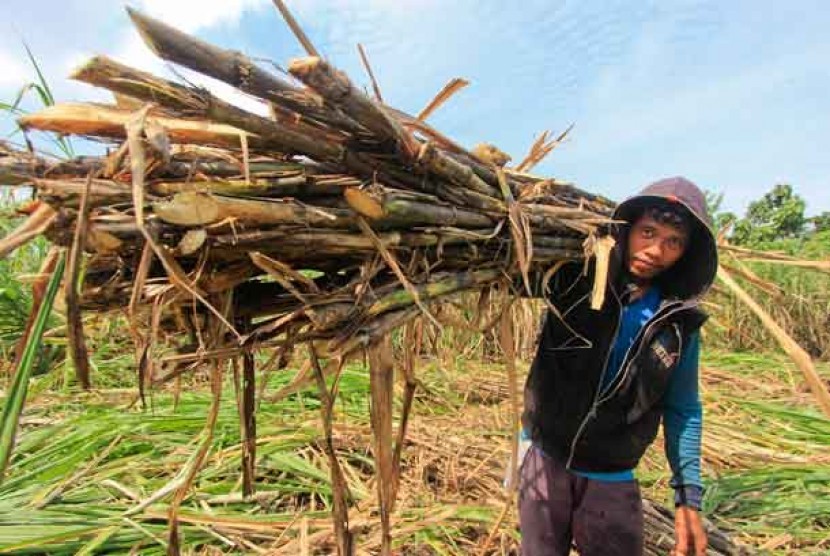REPUBLIKA.CO.ID, JAKARTA -- Indonesia's sugar output has continued to fall over the past few years, and it seems the country will not be able to achieve self-sufficiency in sugar production in 2014.
The decline in sugar output forced the government to lower its production target for 2011 to 2.57 million tons from 2.7 million tons. But production still fell short of the target. By the end of 2011, sugar production stood at 2.26 million tons.
In 2012, sugar production rose 30 percent to 2.7 million tons from a year earlier. Though it fell short of the previous target of 4.4 million tons, it was higher than the revised target of 2.6 million tons.
In 2013, sugar production is projected to drop 10-20 percent from 2012 due to a weather anomaly. Areas around sugar mills in the country saw more rains than usual this year.
The prolonged rainy season, which continued until mid-August, not only lowered sugarcane quality but also affected sugarcane farming. Under normal conditions, the milling period of May-June falls in the dry season.
A similar weather anomaly which led to a prolonged rainy season also affected the country in 2010. As a result, national sugar output fell to 2.26 million tons in 2011 from 2.28 million tons the year before.
The Indonesian Agronomists Association (PERAGI) estimates domestic sugar production this year to reach 2.5 million tons, well below the national consumption of 5.8 million tons.
"With a shortfall imminent in sugar output, I think it will be impossible for the country to achieve self-reliance in sugar production in 2014," said the association's chief, Ahmad Mangga Barani, on the sidelines of a national sugar workshop held at the IPB Convention Center in Bogor, West Java, on Monday.
Going by the low sugar production in the past five years, the country will find it hard to achieve self-sufficiency in sugar production next year, he observed.
He attributed the low sugar production to the slow expansion of sugarcane plantations, the limited use of high-yielding seeds, and poor management of sugar production.
On average, one hectare of sugarcane plantation produces four-five tons of sugar, he noted.
"Our sugar production hit an all-time high of 2.8 million tons in 2008. But since then, it has continued to fall," he stated.
Director of the Indonesian Sugar Plantation Research Center (P3GI), Aris Toharisman, predicted national sugar production will drop to 2.3 million tons this year from 2.7 million tons last year.
"Sugar production is likely to fall this year due to the prolonged rainy season in most sugar mills since the start of the milling season in June," he said after a discussion with directors of sugar mills in Surabaya, East Java, last September.
The sugar production in 2013 will only be enough to meet 40 percent of national consumption, he added.
"The figure suggests that self-reliance in sugar production will be difficult to achieve in 2014," he noted.
The government had set a sugar production target of 2.8 million tons for 2013, but later revised it downward to 2.7 million tons.
Agriculture Minister Suswono said early in October that slow growth of sugar mills was responsible for low sugar output.
To achieve self-reliance in sugar production, the country needs 25 more sugar mills, he stated.
"I hope there will be 20 to 25 new sugar mills. But in the past four years, we could only establish one new sugar factory," he added.
The country has 450,000 hectares of sugarcane plantation at present, but it needs another 350,000 hectares to achieve self-sufficiency in sugar production in 2014, the minister said.
Agricultural observer Khudori of the Indonesian Political and Economic Association recently suggested that the government adopt three steps to achieve self-reliance in sugar production: expanding the area under sugarcane plantation, improving the productivity of sugar plantations, and revitalizing sugar mills.
The government can raise the productivity of sugarcane growers by providing them with high-yielding seeds, he said.
He said the center has discovered high-yielding seeds that can help the country achieve self-reliance in sugar production.
"But the problem is whether farmers are ready to use the high-yielding seeds," he noted.
The second step towards achieve self-reliance in sugar production is improving the management of the sugar industry, from the level of planting to milling the sugarcane, he said.
"State-owned sugar mills have so far not been able to adopt a well-integrated management system," he observed.
State sugar mills in Java have not integrated the planting and milling processes because they have no sugarcane plantations, he added.
"This is different from private sugar mills which have sugarcane plantations. So, they can integrate their planting, felling, and milling processes," he explained.
He said state sugar mills also need to revitalize their aging machines to increase production. (Suharto)


